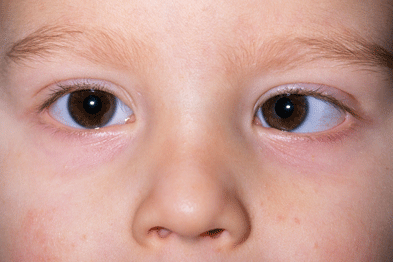Heterotropia
Heterotropia is a condition characterized by misalignment of the eyes. This visual disorder can affect people of all ages, impacting their vision and overall eye health. It is the type of strabismus and it is also known as menifest squint.

Heterotropia occurs when the eyes are not properly aligned and do not work together. One eye may turn inward, outward, upward, or downward while the other remains focused on the intended target. This misalignment can lead to double vision and may affect depth perception.Several factors can contribute to the development of heterotropia.
Causes
Common causes include:
Muscle Imbalance: An imbalance in the eye muscles can result in one eye turning in a different direction.
Nerve-related Issues: Problems with the nerves that control eye movement can lead to misalignment
Genetic Factors: Heterotropia can run in families, indicating a genetic predisposition
Refractive Errors: Uncorrected vision problems such as nearsightedness or farsightedness may contribute to eye misalignment
Symptoms
Following are the symptoms for heterotropia
Visible Eye Misalignment: One eye appearing to turn in a different direction than the other
Double Vision: Seeing two images instead of one, especially when looking at close objects
Eye Fatigue: Struggling to maintain focus, leading to tired or strained eyes.
Headaches: Persistent headaches, particularly after reading or other visually demanding activities.
Types
Following are the types of heterotropia
Esotropia is a type of heterotropia where one eye turns inward, towards the nose, away from the centre. This condition can manifest intermittently or persistently and may be present from infancy or develop later in life.
Exotropia
It is the deviation of eye away from the centre towards the lateral canthus. This type of heterotropia can be noticeable during periods of fatigue or stress and may affect individuals of all ages. Exotropia can be linked to issues with eye muscle coordination, leading to the eye drifting outward.
Hypertropia
Hypertropia refers to a condition where one eye is positioned higher than the other. This upward gaze misalignment can result from muscle imbalances or neurological issues affecting the control of eye movements. Hypertropia may cause double vision and challenges in perceiving depth.
Hypotropia
Hypotropia involves one eye turning downward. This type of heterotropia can impact visual acuity and depth perception. Like other forms of strabismus, hypotropia may be associated with muscular imbalances, nerve dysfunction, or other underlying health conditions.
Alternating Heterotropia
Alternating heterotropia is characterized by a dynamic misalignment, where the affected eye alternates between turning in different directions. This variability can make diagnosis and treatment more complex, requiring a thorough examination by an eye care professional to determine the underlying cause.
Clinical Examination: Diagnosing hypertropia begins with a comprehensive eye examination by a qualified eye care professional. During this examination, the eye doctor will assess several key factors:
- Eye Alignment: The doctor will observe the alignment of the eyes in different gaze positions, looking for any deviation or misalignment.
- Cover Test: The cover test involves covering one eye at a time and then uncovering it while observing the movement of the eyes. This helps detect any eye drift.
- Visual Acuity: The clarity of vision in each eye is evaluated to identify any potential amblyopia (lazy eye) associated with hypertropia.
- Refraction: Determining the refractive error, if any, is essential to address any underlying vision issues contributing to hypertropia.
Medical History and Symptoms: A thorough understanding of the individual’s medical history, as well as any reported symptoms, is crucial for accurate diagnosis. Individuals or parents should communicate any noticeable signs, such as double vision, eye fatigue, or changes in eye alignment.
Ocular Motility Testing: Ocular motility testing assesses the ability of the eyes to move in different directions. This helps identify any weakness or imbalance in the eye muscles that could contribute to hypertropia.
Diagnosis of hypertropia
Prism Cover Test Mastery: Art and Science
The Prism Cover Test stands as a foundational tool in hypertropia evaluation, but its true potential is unleashed through meticulous execution. Expert practitioners consider not only the magnitude of deviation but also the direction, utilizing prisms of varying strengths with a keen eye on the patient’s refractive status.
Hirschberg test
The Hirschberg test is primarily used to assess and confirm the presence of strabismus or eye misalignment. The Hirschberg test provides information about the direction of the eye misalignment. The examiner can estimate whether the eye is deviating inward (esotropia), outward (exotropia), upward (hypertropia), or downward (hypotropia). While the Hirschberg test provides a qualitative assessment, it can offer a rough estimate of the degree of ocular deviation. This information is valuable for initial screening purposes.
Krimsky test and prism reflection test
The Krimsky test is a clinical method used to estimate the amount and direction of ocular deviation in strabismus (misalignment of the eyes). It is often employed when assessing patients, particularly during a prism cover test, to quantify the degree of strabismus. The prism is placed in front of good or fixating eye.
Both krimsky and prism cover test help to measure the angle of menifested deviation of the eye.
Addressing heterotropia often involves a combination of therapies. Treatment options include:
- Eye Patching: Covering the stronger eye to encourage the weaker eye to strengthen and align properly.
- Vision Therapy: Specialized exercises to improve eye coordination and strengthen eye muscles.
- Surgery: In severe cases, surgical intervention may be recommended to correct muscular imbalances.
Founder of EyesMatterMost- an optometry student who loves talking about eyes. I tend to cover topics related to optometry, ophthalmology, eye health, eyecare, eye cosmetics and everything in between. This website is a medium to educate my readers everything related to eyes.
